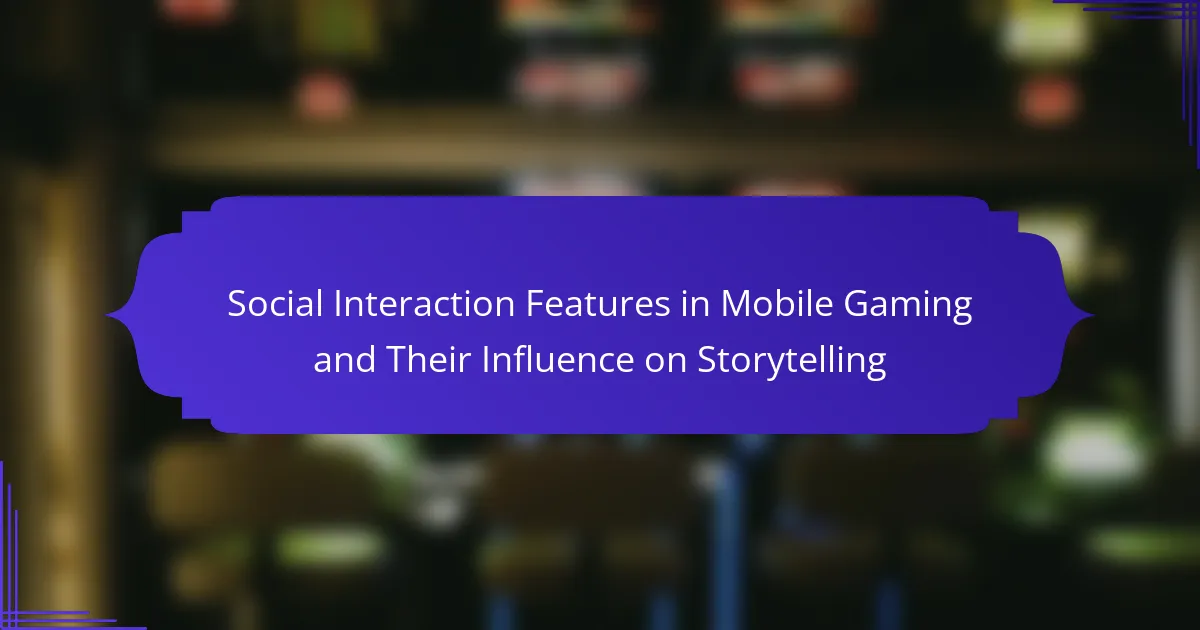Social interaction features in mobile gaming enhance player engagement and emotional investment. These features foster collaboration and community, allowing players to influence narratives collectively. Effective platforms like social media networks and messaging apps facilitate real-time communication, enriching storytelling experiences. Cultural contexts also shape these interactions, affecting how narratives resonate with diverse player backgrounds.
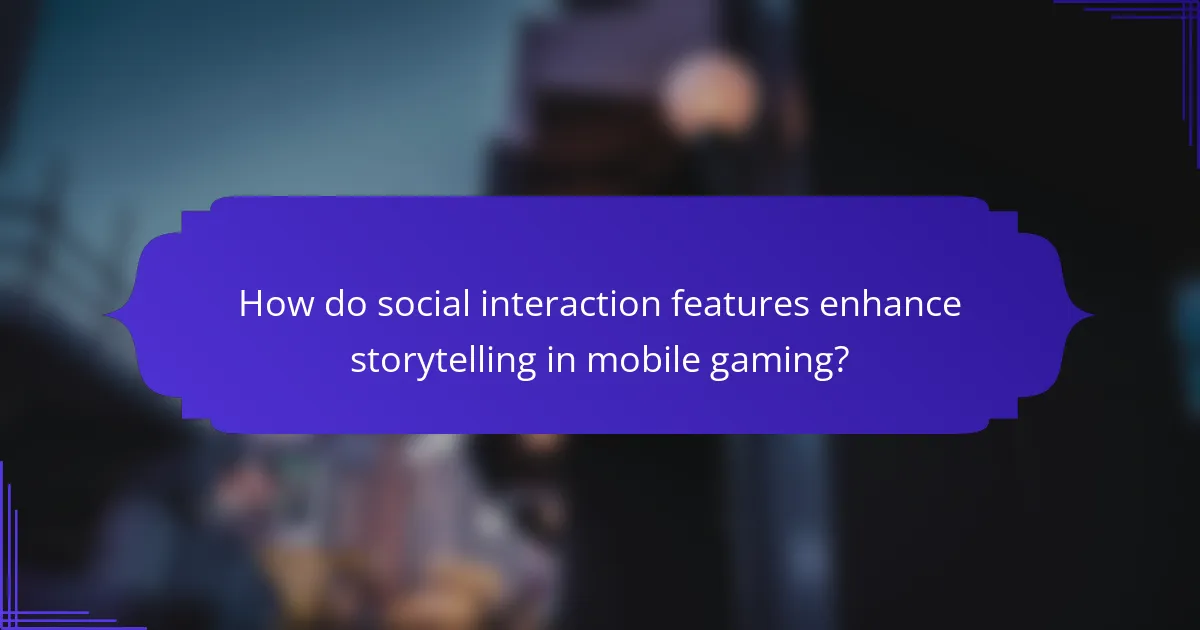
How do social interaction features enhance storytelling in mobile gaming?
Social interaction features significantly enhance storytelling in mobile gaming by fostering player engagement and emotional investment. These features allow players to share experiences, collaborate, and influence narratives collectively. For example, multiplayer modes enable players to shape story outcomes through their choices, creating a unique narrative for each session. This collaborative storytelling deepens emotional connections and enhances replayability, as players explore different paths and outcomes together. Additionally, social features like leaderboards and achievements motivate players to participate actively, further enriching the narrative experience.
What are the primary types of social interaction features in mobile games?
The primary types of social interaction features in mobile games include chat systems, friend lists, multiplayer modes, and social media integration. These elements enhance player engagement and influence storytelling by fostering collaboration and competition.
Chat systems allow real-time communication, enriching narrative experiences. Friend lists enable players to connect, share achievements, and participate in cooperative gameplay. Multiplayer modes create dynamic interactions, impacting story progression through player choices. Social media integration facilitates sharing in-game moments, extending storytelling beyond the game itself.
How do these features impact player engagement and narrative immersion?
Social interaction features significantly enhance player engagement and narrative immersion in mobile gaming. These features foster connections among players, allowing them to share experiences and collaborate on storytelling.
For instance, in-game chat systems enable real-time communication, leading to deeper emotional investment in narratives. Cooperative gameplay mechanics encourage teamwork, enhancing the story’s impact through shared objectives.
Additionally, social media integration allows players to showcase achievements, further enriching the narrative through community interaction. The unique attribute of player-driven storytelling emerges as players contribute to plot developments, creating personalized experiences.
As a result, these social features not only increase engagement but also create a more immersive narrative landscape, making players feel part of the story.
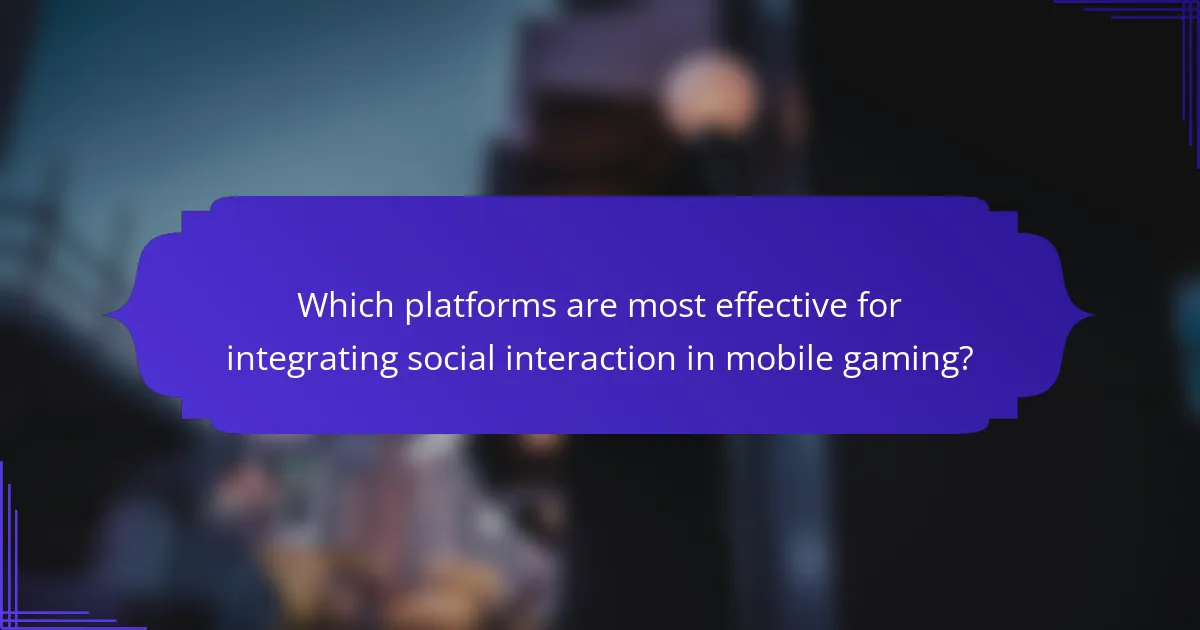
Which platforms are most effective for integrating social interaction in mobile gaming?
The most effective platforms for integrating social interaction in mobile gaming include social media networks, messaging apps, and dedicated gaming platforms. These platforms enhance storytelling by enabling real-time communication, community building, and shared experiences.
Social media networks like Facebook and Instagram allow players to share achievements and connect with friends, enriching the narrative experience. Messaging apps facilitate group play and discussions, fostering deeper engagement with the game’s story. Dedicated gaming platforms, such as Discord, provide tailored environments for interaction, enhancing collaboration and immersion in the game’s world.
Ultimately, the integration of social interaction features on these platforms significantly influences player engagement and narrative depth in mobile gaming.
What role do social media integrations play in mobile game storytelling?
Social media integrations enhance mobile game storytelling by fostering player engagement and community interaction. These features allow players to share experiences, achievements, and narratives, creating a richer storytelling environment. For example, players can post game moments on social platforms, amplifying the game’s reach and narrative depth. This integration leads to collaborative storytelling, where player choices influence the game’s direction, enhancing immersion. As a result, social media serves as a catalyst for dynamic storytelling, making narratives more relatable and expansive.
How do user-generated content and community features influence narratives?
User-generated content and community features significantly enhance storytelling in mobile gaming by fostering player engagement and collaboration. These elements create immersive narratives that evolve through shared experiences and contributions.
1. User-generated content allows players to shape storylines, leading to diverse narratives that reflect community interests.
2. Community features, such as forums and chat functions, facilitate discussions that deepen players’ emotional connections to the game’s story.
3. Collaborative gameplay encourages players to develop collective narratives, enriching the overall gaming experience.
4. The integration of feedback from players can lead to dynamic updates in storylines, keeping content fresh and relevant.
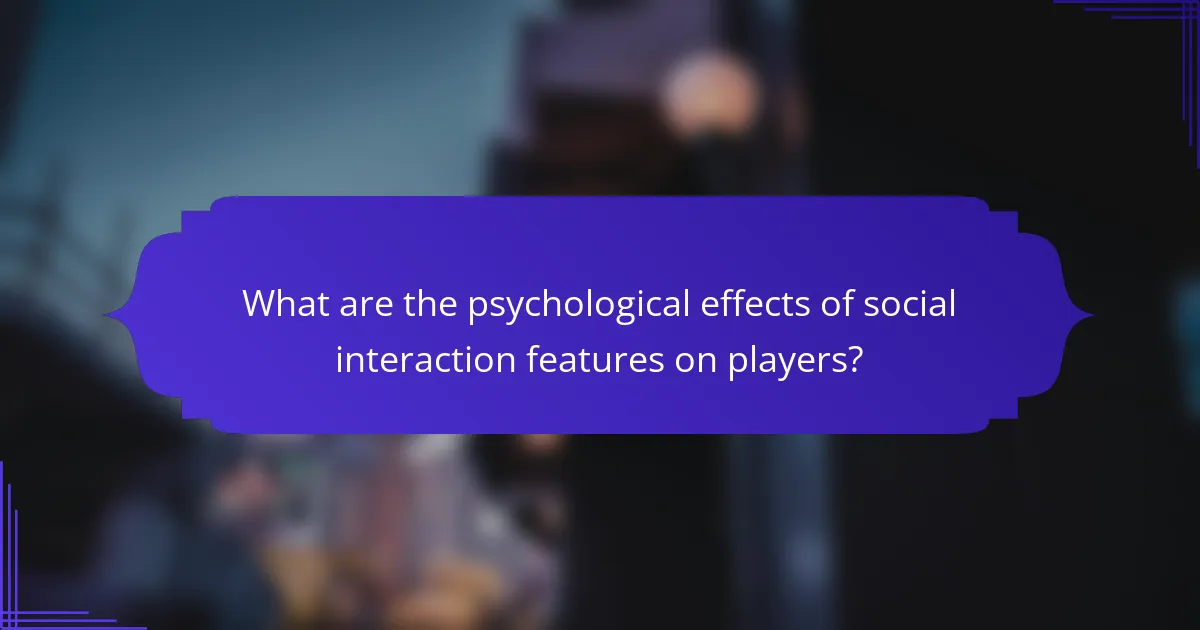
What are the psychological effects of social interaction features on players?
Social interaction features in mobile gaming significantly enhance players’ psychological experiences. These features foster community, increase engagement, and improve storytelling through shared narratives. Players often feel a sense of belonging, which can lead to increased emotional investment in games. Additionally, social interactions can enhance motivation by creating a competitive atmosphere and encouraging collaboration. As a result, players experience heightened satisfaction and enjoyment, reinforcing their connection to the game.
How do social interactions influence emotional connections to game characters?
Social interactions significantly enhance emotional connections to game characters by fostering player engagement. Features like multiplayer modes and chat systems allow players to share experiences, deepening their attachment to characters. Cooperative gameplay encourages teamwork, leading to shared narratives that resonate emotionally. Additionally, social features enable players to form communities, which amplify the emotional stakes of character-driven stories. As a result, these interactions create a more immersive and personalized gaming experience, strengthening the bond between players and characters.
What are the implications of multiplayer dynamics on storytelling?
Multiplayer dynamics significantly enhance storytelling by fostering player engagement and emotional investment. Social interactions create shared experiences that deepen narrative immersion. Players influence story outcomes through collaboration or competition, adding layers of complexity. This interactivity can lead to unique narratives shaped by player choices, making each gameplay experience distinct. Additionally, community-driven storytelling often emerges, where players contribute to lore and character development, enriching the overall narrative landscape.
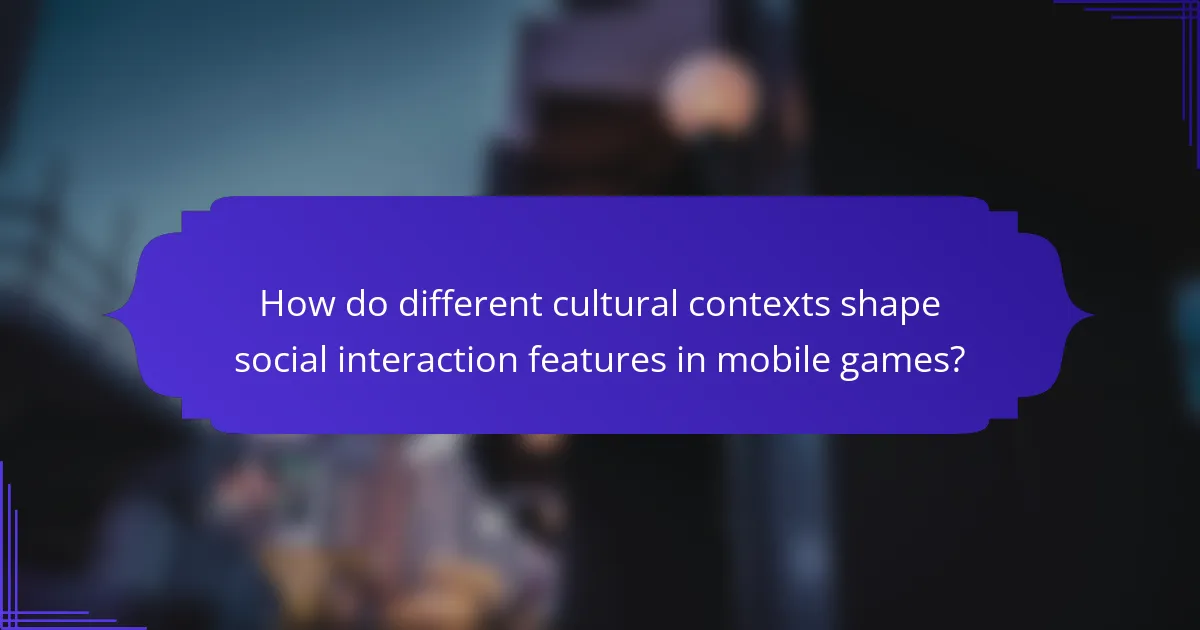
How do different cultural contexts shape social interaction features in mobile games?
Cultural contexts significantly shape social interaction features in mobile games, influencing storytelling. Different cultures prioritize various social norms, communication styles, and community values, which affect how players interact within games. For instance, collectivist cultures may emphasize teamwork and collaboration, enhancing narrative depth through cooperative storytelling. In contrast, individualistic cultures might favor personal achievements and competition, leading to unique character arcs and personal storylines. These variations create diverse gaming experiences that resonate with players’ cultural backgrounds, enriching the overall narrative.
What unique attributes can be found in social features across different regions?
Social interaction features in mobile gaming vary significantly across regions, reflecting cultural preferences. Unique attributes include localized communication styles, varying social norms, and distinct storytelling preferences that influence gameplay. For example, Asian markets often emphasize community-building features, while Western audiences may prioritize competitive elements. These differences shape how narratives are crafted and experienced in games.
How do player expectations vary by region in terms of social storytelling?
Player expectations for social storytelling in mobile gaming differ significantly by region. Cultural values and social norms shape how players engage with narratives and interact with others.
In regions with a strong emphasis on community, players often expect rich, collaborative storytelling experiences that foster interaction. For example, in East Asia, mobile games frequently integrate social features that allow players to share story elements and collaborate on quests.
Conversely, in Western regions, players may prioritize individual storytelling experiences, focusing more on personal achievement and narrative depth. This results in games that emphasize character development and solo quests, with fewer social interactions.
Overall, understanding these regional differences is crucial for game developers aiming to enhance social storytelling features in mobile games.
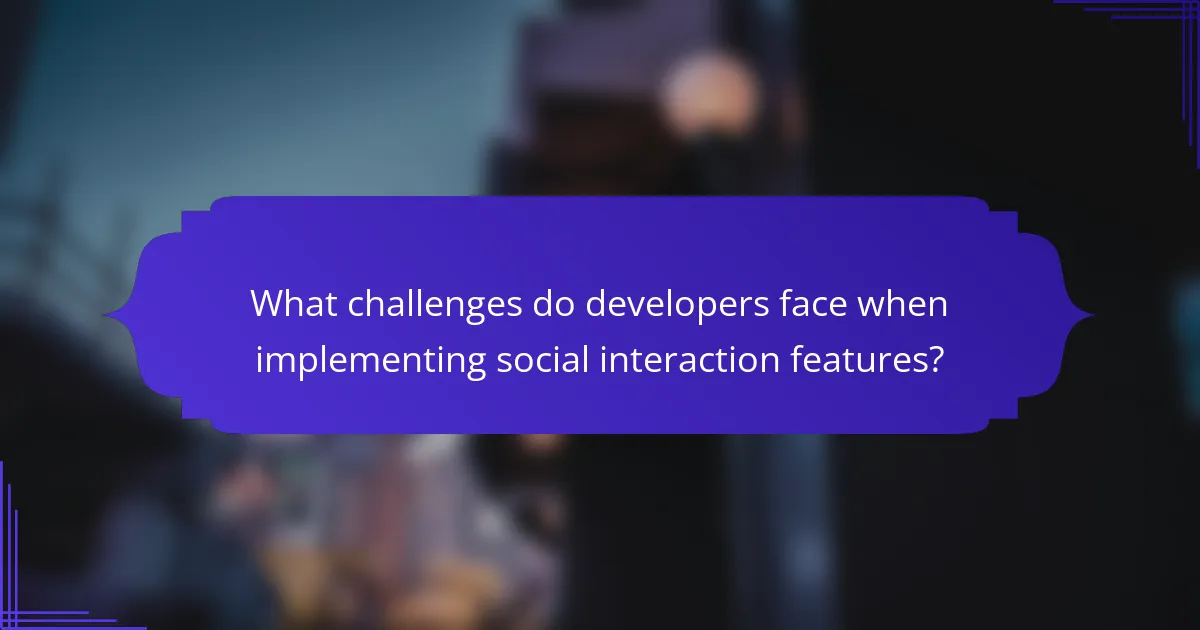
What challenges do developers face when implementing social interaction features?
Developers face several challenges when implementing social interaction features in mobile gaming. Technical limitations often hinder seamless integration of these features. User experience design is crucial; poorly designed interactions can frustrate players. Balancing competitive and cooperative elements is essential to maintain engagement. Additionally, ensuring player safety and moderating content can be resource-intensive. These factors collectively influence the effectiveness of storytelling within the game.
How can developers balance social features with gameplay mechanics?
Developers can balance social features with gameplay mechanics by integrating them seamlessly into the game narrative. This enhances player engagement and storytelling depth.
Social interaction features, such as cooperative missions and leaderboards, can motivate collaboration among players. These mechanics foster community building while maintaining core gameplay elements.
Incorporating social features can provide players with unique attributes, like personalized narratives influenced by friends’ choices. This adds a rare layer of depth and encourages players to share experiences, enhancing the overall game story.
Balancing these elements requires careful design to ensure that social interactions do not overshadow gameplay mechanics, preserving the game’s primary objectives and enjoyment.
What are common pitfalls in designing social interaction systems?
Common pitfalls in designing social interaction systems include neglecting user experience, failing to balance competition and cooperation, and overlooking cultural differences. These issues can hinder player engagement and storytelling. For example, a lack of intuitive interfaces may frustrate users, while excessive competition can alienate cooperative players. Additionally, not considering diverse cultural backgrounds can lead to misunderstandings in communication and gameplay. Addressing these pitfalls is crucial for enhancing social interaction features in mobile gaming, ultimately enriching the narrative experience.
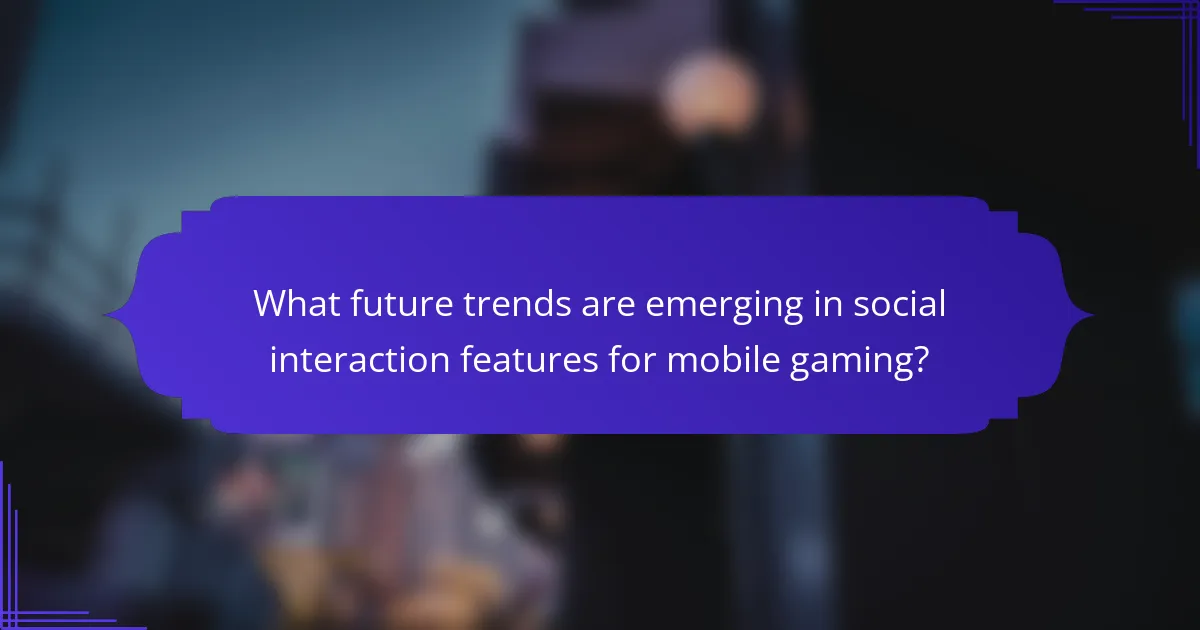
What future trends are emerging in social interaction features for mobile gaming?
Emerging trends in social interaction features for mobile gaming include enhanced multiplayer experiences, real-time communication tools, and integration of social media platforms. These innovations foster deeper storytelling by allowing players to engage collaboratively and share narratives.
For instance, live-streaming features enable players to narrate their gameplay, creating a shared storytelling environment. Furthermore, augmented reality (AR) enhances social interactions by blending real-world elements with gameplay, enriching narrative immersion.
As a result, developers are focusing on community-building tools that promote user-generated content, allowing players to shape narratives collectively. This trend reflects a shift towards more interactive and personalized gaming experiences.
How is technology shaping the evolution of social storytelling?
Technology is significantly enhancing social storytelling in mobile gaming. It fosters real-time interaction, allowing players to share narratives and experiences collaboratively. Features like chat systems, multiplayer modes, and social media integration create immersive environments where stories evolve through player contributions.
For instance, games that incorporate user-generated content enable players to shape narratives, leading to unique storytelling experiences. This participatory approach not only enhances engagement but also builds community around shared stories. As a result, mobile gaming is transforming traditional storytelling into a dynamic, interactive process.
What best practices should developers follow for effective social interactions?
Developers should prioritize user engagement, community building, and seamless integration of social features. Effective social interactions enhance storytelling by creating emotional connections and fostering collaboration among players.
1. Design intuitive interfaces that encourage communication.
2. Implement features like chat, friend lists, and multiplayer modes.
3. Foster a positive environment through moderation and user reporting.
4. Utilize player feedback to improve social features continuously.
